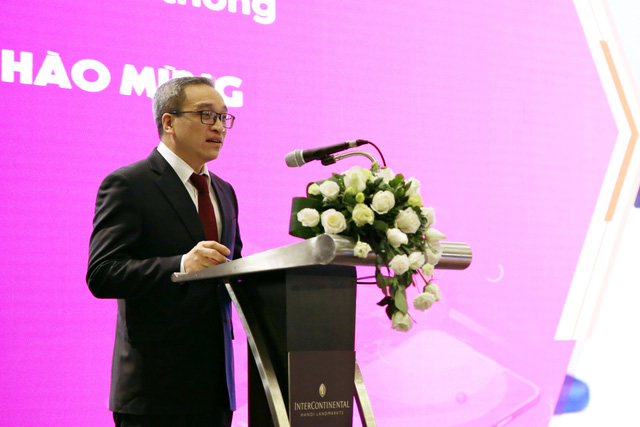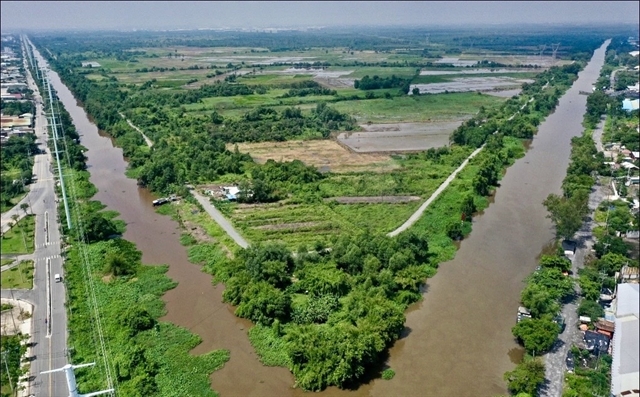 Economy
Economy


|
| Deputy Minister of Information and Communications Phan Tâm speaks at the event. — Photo vtv.vn |
HÀ NỘI — Việt Nam had the highest rate of new digital service consumers in the Southeast Asia region last year, the World Mobile Broadband & ICT 2021 conference was told in Hà Nội on Thursday.
This is an important forum for telecommunications managers and experts to promote the development of services in the Vietnamese market. The theme of this year is developing 5G and broadband infrastructure to enhance the digital transformation process in Việt Nam.
The report "e-Conomy SEA 2020”, which is conducted by Google, Temasek and Bain & Company, showed that Việt Nam's digital economy reached a total value of US$14 billion last year, $2 billion higher than that of the same period of the previous year.
Out of the total number of digital service users in Việt Nam, new users account for 41 per cent. This turned Việt Nam into a country with the highest rate of new digital service consumers in the region.
Statistics from the General Statistics Office said that Việt Nam was one of the three Asian countries with positive growth with the size of the economy is more than $343 billion. Singapore reached $337.5 billion and Malaysia reached $336.3. billion.
The Vietnamese Government has defined one of the pillars of the digital economy as the telecommunications infrastructure, including both mobile and fixed broadband infrastructure.
The development of broadband infrastructure has paved the way for all other economic sectors to grow within the past two to three years.
The total number of fixed broadband subscribers in Việt Nam exceeded 17.2 million, the total number of mobile broadband subscribers reached nearly 69.5 million by the end of last month, reported the Việt Nam Telecommunications Authority.
However, in order to contribute to the realisation of the national digital transformation project by 2030 and further promote the digital economy, telecommunication investment and exploitation activities in Việt Nam, it still needs a lot of innovation.
Assessing the development of Việt Nam's telecommunications market, Trần Đức Lai, chairman of the Radio and Electronics Association of Việt Nam, said this year, operators had deployed 5G and achieved very positive results.
The country will test 5G on a large scale and even with Make- in-Việt Nam devices from this year.
Speaking at the opening session, Phan Tâm, Deputy Minister of Information and Communications, said that we were entering a digital age and digital society.
The world would continue to witness great changes in the next 10 years, he said, adding that it was a transition from the real world to the virtual world and the transformation of all socio-economic activities into a digital environment.
Data would become an important resource for each country and strong development of connection of all things, he added.
The deputy minister said telecommunications infrastructure was becoming the fundamental infrastructure for the digital economy, digital society and digital government. Mobile and fixed broadband infrastructure would contribute greatly to the development of the country.
A study by the National Institute of Information and Communications Strategy said that the contribution of 5G to the national GDP growth is forecast to reach 7.34 per cent by 2025.
The socio-economic development strategy for the 2021-2030 period and the socio-economic development plan for the 2021-2025 period have repeatedly mentioned digital transformation, telecommunications, digital technology, digital government, and digital skills.
Science, technology, innovation and digital transformation are some of the strategic breakthroughs of the next 10 years to help Việt Nam develop and be among the top middle-income countries by 2030 and high-income industrial countries in 2045.
In that context, the Ministry of Information and Communications is determined to keep pace with the world and be proactive in deploying commercialisation of 5G in Việt Nam.
Also speaking at the event, Michael Jiang, Huawei Việt Nam CTO, said there had been more than 140 carriers in 61 countries around the world deploying 5G networks. The 5th generation mobile network had around 260 million users worldwide.
The current Vietnamese network operators were using most of the indoor networks. That raises many costs, such as construction, procurement of home equipment, site rental costs, electricity costs for the station's cooling and air conditioning system, said Jiang.
The optimal solution for Vietnamese network operators was to switch to outdoor solutions. These were devices that are hung directly on poles so there is no need to build stations, reducing air-conditioning costs, he added.
According to Huawei's estimate, with a network of 30,000 stations, the outdoor solution could help Vietnamese operators save operating costs of up to US$133 million per year. — VNS




